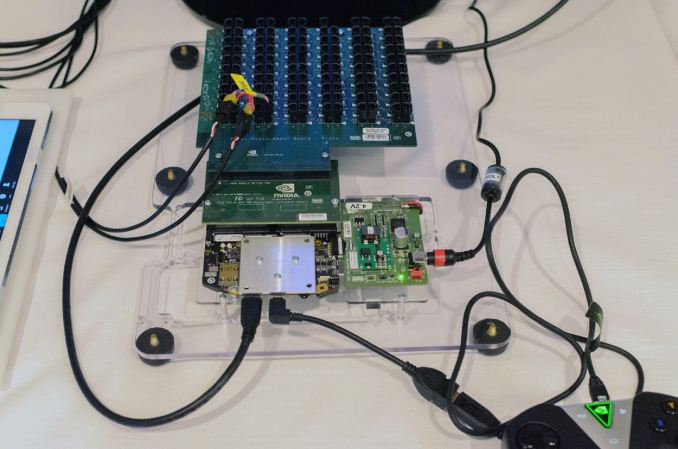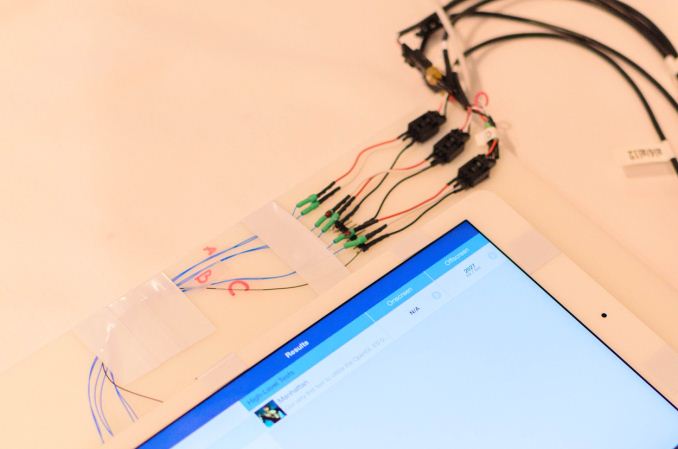NVIDIA Tegra X1 Preview & Architecture Analysis
by Joshua Ho & Ryan Smith on January 5, 2015 1:00 AM EST- Posted in
- SoCs
- Arm
- Project Denver
- Mobile
- 20nm
- GPUs
- Tablets
- NVIDIA
- Cortex A57
- Tegra X1
GPU Performance Benchmarks
As part of today’s announcement of the Tegra X1, NVIDIA also gave us a short opportunity to benchmark the X1 reference platform under controlled circumstances. In this case NVIDIA had several reference platforms plugged in and running, pre-loaded with various benchmark applications. The reference platforms themselves had a simple heatspreader mounted on them, intended to replicate the ~5W heat dissipation capabilities of a tablet.
The purpose of this demonstration was two-fold. First to showcase that X1 was up and running and capable of NVIDIA’s promised features. The second reason was to showcase the strong GPU performance of the platform. Meanwhile NVIDIA also had an iPad Air 2 on hand for power testing, running Apple’s latest and greatest SoC, the A8X. NVIDIA has made it clear that they consider Apple the SoC manufacturer to beat right now, as A8X’s PowerVR GX6850 GPU is the fastest among the currently shipping SoCs.
It goes without saying that the results should be taken with an appropriate grain of salt until we can get Tegra X1 back to our labs. However we have seen all of the testing first-hand and as best as we can tell NVIDIA’s tests were sincere.
| NVIDIA Tegra X1 Controlled Benchmarks | |||||
| Benchmark | A8X (AT) | K1 (AT) | X1 (NV) | ||
| BaseMark X 1.1 Dunes (Offscreen) | 40.2fps | 36.3fps | 56.9fps | ||
| 3DMark 1.2 Unlimited (Graphics Score) | 31781 | 36688 | 58448 | ||
| GFXBench 3.0 Manhattan 1080p (Offscreen) | 32.6fps | 31.7fps | 63.6fps | ||
For benchmarking NVIDIA had BaseMark X 1.1, 3DMark Unlimited 1.2 and GFXBench 3.0 up and running. Our X1 numbers come from the benchmarks we ran as part of NVIDIA’s controlled test, meanwhile the A8X and K1 numbers come from our Mobile Bench.
NVIDIA’s stated goal with X1 is to (roughly) double K1’s GPU performance, and while these controlled benchmarks for the most part don’t make it quite that far, X1 is still a significant improvement over K1. NVIDIA does meet their goal under Manhattan, where performance is almost exactly doubled, meanwhile 3DMark and BaseMark X increased by 59% and 56% respectively.
Finally, for power testing NVIDIA had an X1 reference platform and an iPad Air 2 rigged to measure the power consumption from the devices’ respective GPU power rails. The purpose of this test was to showcase that thanks to X1’s energy optimizations that X1 is capable of delivering the same GPU performance as the A8X GPU while drawing significantly less power; in other words that X1’s GPU is more efficient than A8X’s GX6850. Now to be clear here these are just GPU power measurements and not total platform power measurements, so this won’t account for CPU differences (e.g. A57 versus Enhanced Cyclone) or the power impact of LPDDR4.
Top: Tegra X1 Reference Platform. Bottom: iPad Air 2
For power testing NVIDIA ran Manhattan 1080p (offscreen) with X1’s GPU underclocked to match the performance of the A8X at roughly 33fps. Pictured below are the average power consumption (in watts) for the X1 and A8X respectively.
NVIDIA’s tools show the X1’s GPU averages 1.51W over the run of Manhattan. Meanwhile the A8X’s GPU averages 2.67W, over a watt more for otherwise equal performance. This test is especially notable since both SoCs are manufactured on the same TSMC 20nm SoC process, which means that any performance differences between the two devices are solely a function of energy efficiency.
There are a number of other variables we’ll ultimately need to take into account here, including clockspeeds, relative die area of the GPU, and total platform power consumption. But assuming NVIDIA’s numbers hold up in final devices, X1’s GPU is looking very good out of the gate – at least when tuned for power over performance.














194 Comments
View All Comments
Yojimbo - Monday, January 5, 2015 - link
I can imagine that NVIDIA might release a Denver-and-updated-Maxwell-powered SOC in 2016 and if Denver is successful then a Pascal-and-Denver-powered SOC in 2017. ??? Unless NVIDIA is able to improve their execution well enough to release a Pascal-powered SOC in time for next year. That last possibility seems a bit far-fetched considering their history in the segment, though.jjj - Monday, January 5, 2015 - link
Actually the high end SoC market won't be competitive since only Qualcomm has integrated modem.Guess 4 Denver cores was not doable on 20nm (die size or clocks) and that's disappointing, was really looking forward to more big cores. If they can get the CPU perf they claim, it's not bad but they might have a small window before 16nm shows up.
Seems another lost year in mobile for Nvidia, if they even care about it anymore, not so sure they do.
A quad Denver in high end, a dual for midrange and glasses, ofc both with integrated modem and maybe they would have been relevant again.
Krysto - Monday, January 5, 2015 - link
Strange that Nvidia still hasn't made big strides with its "soft-modem" that was supposed to easily support multiple bands at once.Yojimbo - Monday, January 5, 2015 - link
The soft-modem thing didn't seem to work out the way they had hoped. They seem to have given up trying to compete with Qualcomm in the smartphone market. The OEMs don't like the soft-modem and don't Iike a separate modem chip. NVIDIA's SOCs just don't differentiate themselves significantly enough from Qualcomm's that the OEMs are willing to accept one of those two things. Plus Samsung controls most of the Android smartphone market and seems to be very comfortable with their supplier system. I bet frustration about that on the part of NVIDIA is probably partially what led to the patent lawsuit. In any case, I wonder what NVIDIA is doing with Icera currently... if they are trying to sell it, or what.PC Perv - Monday, January 5, 2015 - link
Not that I think Denver is great or terrible or anything, but modems are not very important on tablets because number of 4G tablets are a fraction of WiFi ones.darkich - Monday, January 5, 2015 - link
Do you people finally see now just how PATHETIC Intel Core M is??Its top of the line chip, done on way superior process, costs $270, has a GPU that manages around 300GFLOPS, while this here 20nm chip that will sell for well under $100, reaches over 1 TERAFLOP!!
And the yearly doubling of the mobile GPU power continues.
Seems like in 2016 we could see small tablets that will be graphically more capable than Xbox one
Krysto - Monday, January 5, 2015 - link
No disagreement there. Broadwell is a dud (weak update to Haswell) and Broadwel-Y/Core M is a scam that will trick users into buying low-performance expensive chips.kron123456789 - Monday, January 5, 2015 - link
"Seems like in 2016 we could see small tablets that will be graphically more capable than Xbox one" - I don't think that even Nvidia can make the SoC with roughly 3x more performance than Tegra X1 within one year. Maybe in 2017-2018?darkich - Monday, January 5, 2015 - link
Well according to raw output, X1 is already close to Xbone (1TFLOPS vs 1.35TFLOPS)Assuming that Nvidia doubles it again next year, even PS4 could be within reach
TheFlyingSquirrel - Monday, January 5, 2015 - link
The 1TFLOPS of the X1 is for FP16. The 1.35 of the Xbox One is FP32. The FP32 performance of teh X1 as stated in the article is 512GFLOPS.